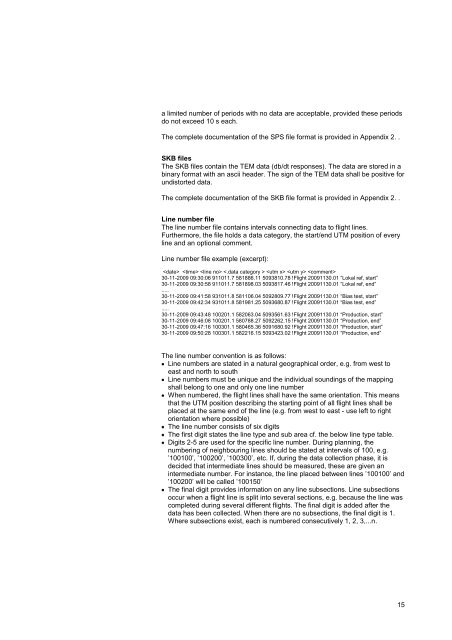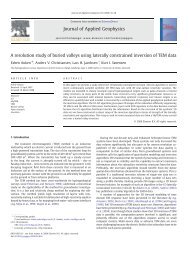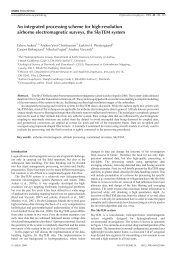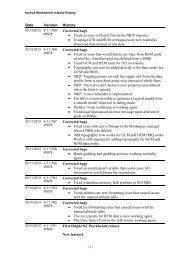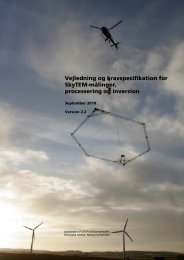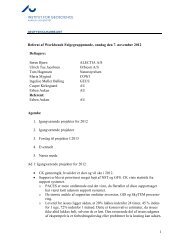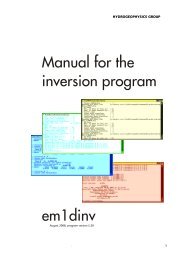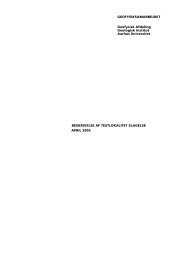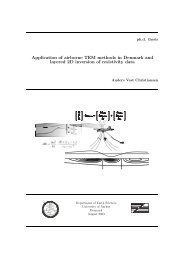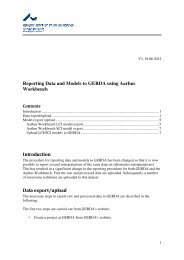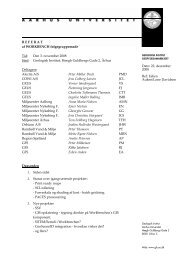guideline and standards for skytem measurements, processing and ...
guideline and standards for skytem measurements, processing and ...
guideline and standards for skytem measurements, processing and ...
You also want an ePaper? Increase the reach of your titles
YUMPU automatically turns print PDFs into web optimized ePapers that Google loves.
a limited number of periods with no data are acceptable, provided these periods<br />
do not exceed 10 s each.<br />
The complete documentation of the SPS file <strong>for</strong>mat is provided in Appendix 2. .<br />
SKB files<br />
The SKB files contain the TEM data (db/dt responses). The data are stored in a<br />
binary <strong>for</strong>mat with an ascii header. The sign of the TEM data shall be positive <strong>for</strong><br />
undistorted data.<br />
The complete documentation of the SKB file <strong>for</strong>mat is provided in Appendix 2. .<br />
Line number file<br />
The line number file contains intervals connecting data to flight lines.<br />
Furthermore, the file holds a data category, the start/end UTM position of every<br />
line <strong>and</strong> an optional comment.<br />
Line number file example (excerpt):<br />
<br />
30-11-2009 09:30:06 911011.7 581886.11 5093810.78 !Flight 20091130.01 “Lokal ref, start”<br />
30-11-2009 09:30:58 911011.7 581898.03 5093817.46 !Flight 20091130.01 “Lokal ref, end”<br />
.....<br />
30-11-2009 09:41:58 931011.8 581106.04 5092809.77 !Flight 20091130.01 “Bias test, start”<br />
30-11-2009 09:42:34 931011.8 581981.25 5093680.87 !Flight 20091130.01 “Bias test, end”<br />
.....<br />
30-11-2009 09:43:48 100201.1 582063.04 5093561.63 !Flight 20091130.01 “Production, start”<br />
30-11-2009 09:46:08 100201.1 580788.27 5092262.15 !Flight 20091130.01 “Production, end”<br />
30-11-2009 09:47:16 100301.1 580465.36 5091680.92 !Flight 20091130.01 “Production, start”<br />
30-11-2009 09:50:28 100301.1 582216.15 5093423.02 !Flight 20091130.01 “Production, end”<br />
The line number convention is as follows:<br />
Line numbers are stated in a natural geographical order, e.g. from west to<br />
east <strong>and</strong> north to south<br />
Line numbers must be unique <strong>and</strong> the individual soundings of the mapping<br />
shall belong to one <strong>and</strong> only one line number<br />
When numbered, the flight lines shall have the same orientation. This means<br />
that the UTM position describing the starting point of all flight lines shall be<br />
placed at the same end of the line (e.g. from west to east - use left to right<br />
orientation where possible)<br />
The line number consists of six digits<br />
The first digit states the line type <strong>and</strong> sub area cf. the below line type table.<br />
Digits 2-5 are used <strong>for</strong> the specific line number. During planning, the<br />
numbering of neighbouring lines should be stated at intervals of 100, e.g.<br />
’100100’, ’100200’, ’100300’, etc. If, during the data collection phase, it is<br />
decided that intermediate lines should be measured, these are given an<br />
intermediate number. For instance, the line placed between lines ’100100’ <strong>and</strong><br />
’100200’ will be called ’100150’<br />
The final digit provides in<strong>for</strong>mation on any line subsections. Line subsections<br />
occur when a flight line is split into several sections, e.g. because the line was<br />
completed during several different flights. The final digit is added after the<br />
data has been collected. When there are no subsections, the final digit is 1.<br />
Where subsections exist, each is numbered consecutively 1, 2, 3,...n.<br />
15


